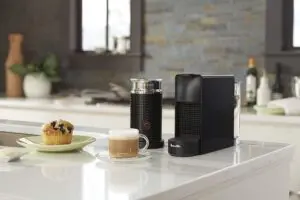Can You Make Espresso With Regular Coffee? Barista Weighs In
Disclosure: This post contains affiliate links and I may earn a small commission (at no extra cost to you) if you click through and make a purchase. Thanks in advance – I really appreciate it!
Many of my friends have asked me this, and I myself as a teenager used to often wonder if I can use the regular coffee beans or coffee grinds in my espresso machine to make a shot of espresso.
Key Takeaways:
Can you make espresso with regular coffee?
Technically, regular coffee can be used to make espresso, but the drink you’ll make may taste sour and tart. Espresso calls for dark roast beans and a fine grind, unlike regular coffee that is ground coarser than espresso grind which makes it unsuitable for high-pressure brewing.
There are more than a few reasons why regular coffee beans won’t produce a balanced shot of espresso with a rich crema. In this article, we will discuss all of them one by one. So read on to find out more!
Can You Make Espresso With Regular Coffee
As I mentioned at the beginning of this article – You can make espresso using regular coffee beans or regular ground coffee, but the beverage that you’ll end up with will taste sour, bitter, and tart.
You may be wondering why will your espresso turn out to be like that.
I can help clear your confusion, but for that, I must explain a few basic differences between espresso brewing and regular filter coffee brewing.
Filter Coffee vs Espresso
Espresso is brewed by forcing highly pressurized hot water through coffee grinds. Filter coffee is brewed in a drip coffee machine where water runs through the coffee grounds solely because of gravity. Also, the coffee is ground much more finely for espresso than for filter coffee.
So the most obvious differences between filter coffee and espresso are in the fineness of their grinds and in their brewing times.
Espresso is a short, sharp shot of coffee that is made in an espresso machine when pressurized water at high temperature is forced through the finely ground coffee.
Filter coffee is most commonly brewed using a drip coffee machine or a pour-over method where hot water is poured over coffee grounds. The water passes through the grounds and a filter of some form and falls into a vessel.
So instead of being pushed through with pressure, the water runs by itself through the coffee grounds because of gravity.
Now that we have learned the basic differences between the two brewing techniques, it will be much easier to understand why your espresso will taste bad if you use regular coffee to make espresso.
Why You Shouldn’t Use Regular Coffee To Make Espresso
Although most coffee beans are either Robusta or Arabica beans, there are a few key differences between the beans meant for brewing espresso and your regular coffee beans.
Espresso beans are dark roast.
Espresso beans are roasted longer and darker than the beans used for regular filter coffee.
Espresso beans are roasted for a longer time, usually past the second crack, so it has a toasted and deeper flavor.
The beans are also roasted for longer, so it removes a lot of the acidity while releasing more oils. This gives espresso a heavier, fuller feeling in the mouth.
Also, the emulsification of these oils, along with other compounds in dark roast coffee beans produces the espresso crema.
Crema is the golden-brown top layer of a shot, made up of proteins, oils, and melanoidins, but most importantly not all coffee can produce crema.
On the other hand, light, medium, and medium-dark roasts are typically used for regular drip coffee brewing.
Coffee connoisseurs all over the world believe in one simple rule that says the light roasts work best with a slower extraction method, such as a filter coffee, whereas darker roasts go with a pressurized brewing method such as making espresso.
So to summarize the above discussion – Using regular beans to make espresso may not produce the kind of brew you expect in a perfect shot of full-bodied espresso, no matter how good they are. Some varieties are too light, others may be too charred or dark.
Espresso calls for a fine coffee grind.
An espresso grind is typically much finer than other types of coffee grinds. This is because the process of making espresso requires hot water being pushed through tightly packed grounds.
The grind size for espresso should be fine, between flour and table salt, because the water comes into contact with them for a shorter period of time.
Filter coffee has a coarser ground because it needs to be brewed for a longer time at a lower temperature.
Only an espresso machine can brew standard espresso.
The difference in brewing technique between espresso and filter coffee is the most important reason why you shouldn’t use regular coffee to make espresso.
While filter coffee can be produced in various different ways, espresso needs to be made using an espresso machine.
An espresso machine uses about 9 bars of pressure to push heated water through coffee grounds within 20-30 seconds. There’s a lot of engineering involved, with every single detail being important for the resulting cup.
Why You Can Use Regular Coffee To Make Espresso
Espresso beans are coffee beans. When it says “espresso” on the bag or can, it’s just the roaster’s recommendation of how to use the beans based on the roast and/or grind.
You can make espresso with any type of coffee bean, roasted anyway, flavored in any fashion, and blended to any taste, just make sure that you grind the beans really fine, like table salt or closer to dust texture.
But keep in mind that your espresso may not have the flavor profile you expect in an espresso. For e.g. espresso roasts are often lower in acidity, higher in richness and body, and have smokier and more chocolatey flavor profiles than lighter roasted beans used for regular drip coffee brewing.
Later in this article, I have explained in detail how you can make espresso with regular beans in an espresso machine.
Can You Use Regular Coffee in an Espresso Machine?
Technically, you can use regular coffee in an espresso machine. However, the espresso produced will taste watery and sour as the espresso machine is designed to use fine coffee grinds while regular coffee is ground coarser than espresso grinds.
Espresso machines create espresso by forcing hot and pressurized water through finely-ground coffee.
Since the hot water is in contact with the ground coffee for a short time period it is necessary for the coffee to have a very fine grind size.
This is because a fine grind size means that more of the coffee will come into contact with the water due to a greater surface area and there will be smaller gaps between the coffee meaning that the water will take longer to pass through it.
Regular ground coffee is generally medium to medium-fine grind size. This is because regular coffee is used to make coffee in a drip coffee machine or by the pour-over method.
Both of these methods involve pouring hot water over coffee grounds and waiting for the coffee to bloom.
This method generally takes some time so the coffee grounds are in contact with water for much longer than in an espresso machine.
By using ground coffee to make the espresso the water will pass through it quickly and it will come into contact with less of the coffee. The result of this is likely to be that the espresso will taste weak and bitter.
How To Make Espresso With Regular Coffee Beans
You’ll need:
- Espresso machine
- Coffee grinder
- 8-10 grams coffee
Product Recommendations
Here’s the Breville espresso machine I use, it works wonderfully and makes the best espresso I’ve had outside of Italy. It’s even better than many coffee shops, in my opinion! It’s pricey, but worth it for coffee nerds.
For grinding your coffee beans I would highly recommend the Breville Smart Grinder Pro for espresso because the finest setting produces fine, even results that don’t clump together.
Step 1: Grind and measure your beans. Using your regular coffee beans and a quality grinder, grind enough beans to make one or two espresso shots.
An average single espresso shot will require between 8 and 10 grams of coffee grounds, although this can be adjusted up or down. For a double shot, about 18 grams. Your grounds should be powdery and fine, so go ahead and use the finest setting on your grinder.
If you want to be sure you measured correctly, you can weigh your grounds on a kitchen scale — just make sure to tare out the portafilter first.
Step 2: Distribute & tamp down. When the coffee grind is inside, make sure to tap the portafilter on the counter or the temp mat, so your grounds can be evenly distributed.
Tamp by applying pressure with your hand. This is important as you need to get rid of any possible air bubbles inside.
Step 3: Pull your shot. Lock the portafilter into the machine, position a cup underneath, and start your shot. Most home espresso machines have an automatic option for this. A well-pulled espresso shot will last around 25 to 30 seconds and have a deep espresso flavor with a nice foamy crema. But since you’re using regular coffee beans, the color, density, and volume of the crema might be slightly different than regular espresso, or there might not be any crema at all.
Conclusion
So now you know why you can and why shouldn’t use regular coffee in your espresso machine to make espresso.
The difference between espresso and coffee is all to do with the way it’s prepared—not the beans themselves.
In general, espresso requires a dark roast, fine grind, and high pressure to create an ounce or two of concentrated coffee.
When paired with water or milk, you can have a delicious espresso drink that will give you a boost of energy, and excite your taste buds as well.

Amit Gupta
Hi, my name is Amit Gupta, and I am the owner and contributor at Cafeish. My obsession with coffee started when I received my first French press as a gift almost ten years ago. Since then, my love of coffee – and the number of coffee gadgets I own – has grown considerably.
Most Popular
ABOUT US
We are a team of coffee affcianados with experience and expertise in making world renowned coffee. In fact, preparing the best coffee ever with a fluffy top reminds us of magic, with secrets of how to achieve each particular effect. Making coffee is not our only hobby, we always keep our ears open as to what’s happening around and what scientists and manufacturers produce for consumers. It’s not an easy task to do – it’s rather time consuming. Hence, Caféish website was launched.
LEGAL DISCLAIMER
Caféish is a participant in the Amazon Services LLC Associates Program, an affiliate advertising program designed to provide a means for sites to earn advertising fees by advertising and linking to Amazon.com. Caféish also participates in affiliate programs with Clickbank and other sites. Caféish is compensated for referring traffic and business to these companies.




